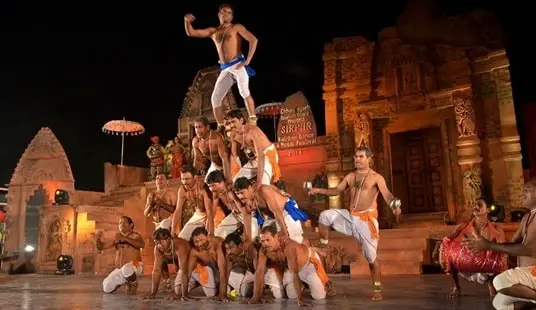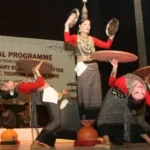In central India, Chhattisgarh stands as the abode of culture. As a part of Indian cultural journey, this state is a latest addition. Not only that the state is well known for the traditional styles of dance, but also for the cultural tapestry those dances have woven throughout the ages. The men and women living here are aware of the history and tales of the land, and through the dance forms, they make these tales come alive.
Panthi Dance

Panthi, a traditional dance, is popular in Chhattisgarh. The historical and cultural panthi dance provides vitality to festivals and social occasions. Panthi dance is rhythmic and powerful, symbolizing unity and endurance. Male and female dancers form a harmonious circle for community strength. Gonda, who opposed oppression and injustice, is the hero of this captivating dance. Panthi dancers’ graceful footwork and hand motions attract audiences. Every step and gesture brings heroes and resistance tales to life. The talented performers and Chhattisgarh’s perseverance shine throughout the performance. Panthi dance tales depict regional history, culture, and society. Mythical hero Gonda represents hope and courage, defining Chhattisgarh’s identity.
Karma Dance
Karma, Chhattisgarh’s vibrant and complicated dance festival, is also a religious and agricultural celebration with great value for local communities. This happy annual festival features the Karma dance, a highlight, with people from all origins. The Karma dance represents unity and environmental respect. It’s a bright celebration of the region’s culture. Men and women wear colorfully for this thankfulness, community, and nature devotion. A decorated tree or branch symbolizes the life force that sustains the land and its people in the Karma dance. To thank the divine for their rich harvest, the dancers sing and move together to the music. Karma dance promotes environmental and human connection, showing that their well-being is linked.
Raut Nacha
An ancient Chhattisgarh Yadav dance, Raut Nacha, praises Lord Krishna. This religious dance tells Krishna and Radha’s story. Raut Nacha is unusual in that only men play beloved women. God Krishna and Radha’s love and funny antics are Raut Nacha’s core. Dancers with elaborate robes, jewelry, and turbans represent these sacred characters. They create a visual and cultural spectacle that moves the audience with each movement and gesture representing love and devotion tales. The Krishna legend-based Raut Nacha dance transports audiences to Vrindavan. It illustrates how the players embody Lord Krishna’s charm and charisma.
Suwa Nacha
Chhattisgarh’s Suwa people perform the entrancing Suwa Nacha. A colorful dance shows the Suwa tribe’s culture, customs, and traditional ceremonies. Tribal festivals bring Suwa Nacha to life, showcasing the tribe’s culture. The precision footwork and rhythmic movements of Suwa Nacha evoke traditional rhythms. Traditional instruments like the dhak and nagara give the show a lasting tone. The Suwa dance represent the culture. It protects and honors their nature-based customs. Suwa Nacha celebrates the tribe’s connection to the land, woodlands, and environment.
Panthi Nritya
Traditional Chhattisgarh dance, Panthi Nritya, is vital to the culture. Religious and social events include this engaging art form, lauded for its graceful and flowing movements that reflect the state’s rich heritage. Panthi Nritya’s poetry and beauty portray Chhattisgarh’s culture. Hindu mythology and culture are brought to life by dancers in bright saris and dhotis. Their narrative and ability to convey complicated tales via movement and emotion attract listeners. Tradition and workmanship mix perfectly in Panthi Nritya. Every step and gesture tells a story of gods, goddesses, and heroes. Dance conveys Chhattisgarh’s spiritual and mythological values, linking audience to culture. Panthi Nritya celebrates culture. Chhattisgarhis may preserve and share their history. Artists and audiences remember Hindu mythology and heritage via dance.
Saila Dance
The beautiful Chhattisgarh Saila dance shows the Gonds’ profound connection to nature. This passionate dance shows their healthy coexistence with nature and their love of the environment and its many resources. Saila dancers use their craft to express this ongoing link between people and nature. Their skin is painted natural colors to highlight their connection to nature. Their attire has traditional ornaments to maintain their culture. Saila dancing rhythms depict Gond hunting and farming. Each step and gesture celebrates the dancers’ rural existence, land dependency, and love of nature. Traditional Saila dance has a message, not simply amusement. This emphasizes environmental conservation and harmony with nature. Gond art promotes stewardship and ecological awareness amid human-environment interaction.
Kaksar Dance
Kaksar, a captivating Muria tribal dance, is vital to Chhattisgarh. More than a performance, this dance is part of the tribe’s traditional traditions and exposes their roots. Kaksar dancers represent their culture in traditional costumes with headpieces and jewelry. The dance showcases Muria tribal life’s numerous features with graceful movements. Gently moving dancers relate stories of hunting, wooing, and other daily activities. Kaksar dance represents Muria heritage preservation. It represents their deep connection to nature, culture, and lifestyle. Each Muria performance preserves their culture in a changing world. Beyond its beauty, kaksar dance maintains Muria history, customs, and rites. Cultural identity and pride in heritage are preserved and passed along.
Jawara Dance
The strong agricultural dance Jawara is a feature in rural Chhattisgarh, where farming families rely on the land. A great technique to thank the gods during planting and harvesting is this dance. Jawara dancers symbolize the earth to maintain an old tradition. The bundles of freshly harvested crops on their heads symbolize Chhattisgarh’s critical harvest. The earth is honored by their rhythmic and joyful celebration. Farmers in Chhattisgarh dance passionately to the ground that supports them. Farmers live there, therefore it represents rural culture. In their energetic movements, Jawara dancers convey their profound connection to the land, rivers, and natural forces that permit enormous harvests.
Conclusion
Among the different states in Northern India, Chattisgarh holds a very important position as a cultural center. The state offers certain richness in its cultural progress. The lifestyle, beliefs and religious concepts have amalgamated in the dances, giving birth to wonderful expressions through movements and rythms.
Santosh Kumar, the author behind IndiasStuffs.com, is passionate about sharing valuable insights on a variety of topics, including lifestyle, technology, and Indian culture.
Page Contents

